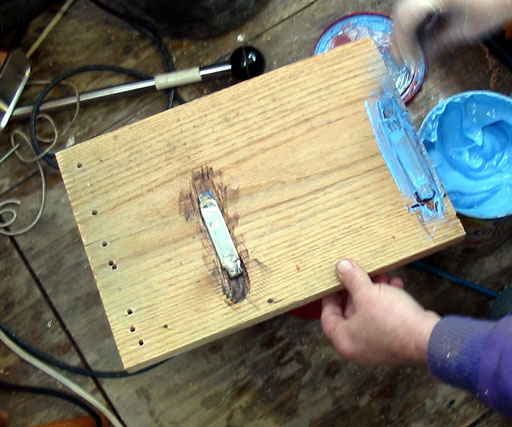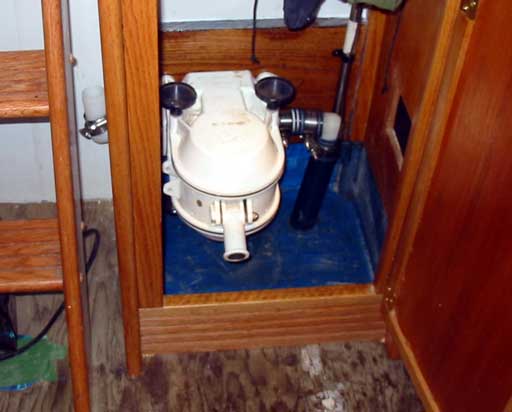| Day 436 |
 |
Manual Bilge pump,
alternator mounting, spindles |
| A friend of ours, well we've known him for quite a while (through work and he hauled our first house), happened upon some "left-overs" from the Edmonton Queen, a paddleboat venture that was to take tourists on a romantic tour up and down the North Saskatchewan river while dining and imbibing as if on the river Sein in Paris. It was in the news often as negligence and problems with the typical winter weather and ice here emerged. Eventually she was parted out, then repurchased and rebuilt etc etc. on it goes, and has been up and running for the past couple of seasons. |
 |
As he is a farmer/modular home
hauler, he had no use for anything marine in nature, but thought of us. One
of the items he donated to our cause was a large Whale Gusher bilge pump.
Being nicer than any of ours purchased on eBay and totally brand new, we
graciously accepted it! Thanks Jim! Today Gena made the mount and installed it. Originally it was to go under the steps up to the cockpit, but the bottom of the dry locker was more clear for the handle, and still leaves room for our "wellies" on the floor. If you recall, a dry locker is for wet clothes, and is waterproofed and located next to the heater if required. Basically it keeps "wet" away from the rest of the interior. A couple of bolts each side welded to the back of some 3/4" ply gives it a sturdy mount. |
| The exit pipe is flat
hose that will be rolled onto a quick-remove spool. This can be thrown out
the door into the cockpit or over the side in the event we are getting
flooded and the electrics fail. The more pumps the better! Gena also rigged a portable electric with it's own hose and long 12 volt extension cord so it can be used anywhere. We have extra hand pumps now so one will be mounted on a board for portable use. |
|
 |
 |
| My job was to add the finishing
touches to Gena's desk. This is in the way of spindle bars. As shown above
and right, the bar is constructed quite heavily so it will support the
weight of someone using is as a hand hold. This requirement was paramount as
"stuff happens" right? Now that useless cabinet top space can be used! The basic shapes were cut out and screwed together with gorilla glue first (it takes several hours to dry for working it. Then the edges routed off nicely, and finally the holes drilled for the spindles. The photo below shows the one on the left of the desk. Now that area can be used for accumulating WEFAX paper from the machine Gena hung above. Sweet! |
 |
 |
|
| Even though the glue has not yet completely cured, the strength is formidable. I tested it with a hard jerk outward. I added silicone to the end that butts into the bulkhead. Next I will make up the numerous spindle bars for around the skylight and on each side of the berth, then perhaps one for the galley. These are, after all, called "galley spindles!" | |
| After the pump mounting, Gena took
advantage of the "warm" day to continue welding another important piece of
hardware, the alternator mount. We already have one alternator mounted on
one side of the engine, but that is just a 50 Amp for the small starter
battery.
For the house batteries, 4 8-D AGM batteries, we need something with a little more 'oomph'! A 210 amp Balmar alternator fit the bill. Even though they are quite expensive ( around 1k$ for it and it's regulator) people tell us that they are worth it. |
 |
| Having a smaller "car
style" alternator would create problems and be generally bad because: a) Diesel engines running while not under way like to have a decent load on them, and consume the same fuel either way b) Because the alternator is smaller, more time is required to charge the batteries, thus more fuel ( very important in 2008+!) c) The regulator isn't set up to charge AGM batteries and may damage them in the long term. ( another 3k$) d) Non-isolated ground is a problem on steel boats. That would leave us with a choice of running a ground wire to the house batteries, thus creating an "electrolysis loop" , or creating a magnetic field in the hull with amperage from using the hull as a ground wire to the battery bank. Bad for us because both of the flux gates are located between the engine and the house batteries. The headache with adding a second alternator is taken in stride by some challenging bracket design. Other problems include the drive belt had to be dual because of the torque level, space on that side of the engine, making sure the thing was isolated ground style, and finding the right type of belt. The first bracket seems to fit well, bolting on to several points, but the other 2 may prove to be even more of as challenge. Glad it's not me doing it! |
|
 |
|
Day 436:
12 hours - made first bracket for alternator, made spindle bars for desk,
mounted whale gusher pump in dry locker